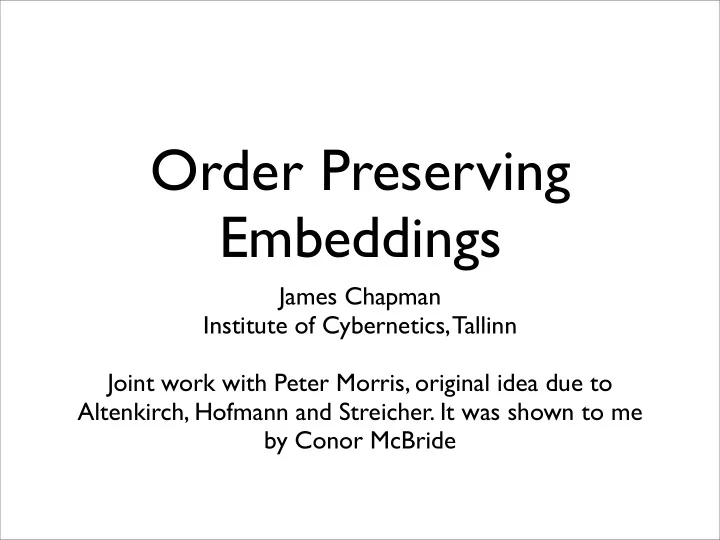

Order Preserving Embeddings James Chapman Institute of Cybernetics, Tallinn Joint work with Peter Morris, original idea due to Altenkirch, Hofmann and Streicher. It was shown to me by Conor McBride
This work in context • I am interested in: • Semantics of programming languages based on lambda-calculus. • Formalised in type theoretic theorem provers such as Agda, Epigram and Coq • In these systems: • Proofs and programs are the same • The types of programs can express their specifications
What’s the problem? • Doing these things in detail, as you are forced to do in a theorem prover, makes it very important to use appropriate representations of things • The greater the level of detail, the greater the choice of representation • A general problem for formal mathematics and programming language semantics
Finite sets data Fin : Nat -> Set where fzero : Fin (suc n) fsuc : Fin n -> Fin (suc n) Pictorial enumeration of the first three instances: Fin zero fzero Fin (suc zero) fsuc fzero fzero Fin (suc (suc zero) Example usage: safe_lookup : Fin n -> Array X n -> X
Untyped Lambda calculus The well-scoped lambda terms data Lam : Nat -> Set where var : Fin n -> Lam n λ : Lam (suc n) -> Lam n app : Lam n -> Lam n -> Lam n Example expressions: λ (var fzero) -- identity function λ ( λ (var (fsuc fzero))) -- ‘K’ combinator
What can you go from here? • Define syntactic operations: • Weakening, substitution, etc. • Implement an evaluator/normaliser • Extend it: • Data types, effects, annotate with simple or dependent types, etc.
Implementing Weakening Weakening adds a fresh variable at the ‘zero’ position and increments the rest weak : Lam n -> Lam (suc n) weak (var x) = var (fsuc x) weak (app t u) = app (weak t) (weak u) weak ( λ t) = λ ? -- we’re stuck We need to generalise from adding a new variable at the end of the context to an arbitrary position
Thinning: A solution? 0 0 1 1 2 2 new variable 3 3 4 We implement it for terms as follows: tlam : Fin (suc n) -> Lam n -> Lam (suc n) tlam x (var y) = var (tvar x y) tlam x (app t u) = app (tlam x t) (tlam x u) tlam x ( λ t) = λ (tlam (fsuc x) t) Ordinary weakening for terms is now easy: weak : Lam n -> Lam (suc n) weak t = tlam fzero t
A better solution: Order Preserving Embeddings 0 0 1 1 2 2 3 3 4 5
OPEs data OPE : Nat -> Nat -> Set where done : OPE zero zero skip : OPE m n -> OPE m (suc n) keep : OPE m n -> OPE (suc m) (suc n) The identity OPE ( id : OPE n n ) is recursively defined The weakening OPE is a now easy to define: oweak : OPE n (suc n) oweak = skip id
Action of OPEs We can easily define the following operation lifting an OPE to a function on lambda expressions olam : OPE m n -> (Lam m -> Lam n) olam f (var x) = var (ovar x) olam f (app t u) = app (olam f t) (olam f u) olam f ( λ t) = λ (olam (keep f) t) Ordinary weakening for terms is now easy: weak : Lam n -> Lam (suc n) weak t = olam oweak t
OPEs form a category • The objects are natural numbers: 0 , 1 , ... • The morphisms are OPEs: f , g , ... • For every object n an OPE id : OPE n n • For every f : OPE l m and g : OPE m n there is an operation • such that f • g : OPE l n • and the following properties hold: • f • id = f and id • f = f • f • (g • h) = (f • g) • h
Why is this a good representation? • Avoids reasoning about functions, first order structures are easier to deal with • Avoids junk, captures only what we want • Simple (elegant?) algebraic structure
Big-step Normalisation • Central part of my thesis: • based on “Big-step Normalisation” by Altenkirch and Chapman • Published (soon!) in Special issue of Journal of Functional Programming. 2009. Eds. C. McBride and T. Uustalu • Big win: simplified reasoning about weakenings; avoids problematic reasoning about context extensions.
Dependent types • OPEs are helpful here for well-typed terms, as even defining variables requires reference to weakening. • If we implement weakening by referring to variables we quickly get into a knot. • OPEs avoid this and the fact the form a category become an integral part of the definition.
Recommend
More recommend